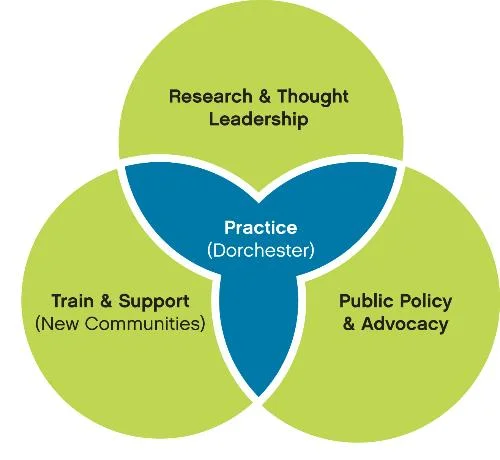Social Impact Strategies
Community activism and social change
Community Research
Providing space to come together
Close to Home believes that achieving our vision will happen if we connect our hands-on experience in local communities to field-level dialogue about the future direction of domestic and sexual violence program practice and policy, and the allocation of resources. Our practical experience working directly with local community members and organizations on the ground gives us a credible voice in the broader landscape. To that end, we will pursue four integrated strategies over the next five years to scale our impact. Close to Home will focus on community building (working with local communities) and field building (working with state, national, and international decision-makers and influencers.)
Practice
Close to Home's Process Diagram.
At the center of our work, Close to Home's practice (strategy?) emphasizes our commitment to ensuring the sustainability and quality of our original site in Dorchester, as well as to advancing the field through ongoing learning and implementation. As the model site, Dorchester serves as Close to Home’s “innovation incubator,” developing effective programs and practices with measurable local impact that can then be shared.
Note: We discussed changes these buckets to reflect our main navigation. Tania thinks that is a good idea. So, organizing locally, Training and Support and Movement Building)
(2.) Train & Support
Through “Train & Support,” Close to Home will focus our energies on providing tools, training, and technical support and learn how to spread our approach through existing organizations. Sites selected for our initial pilot will benefit from the development of a “community of practice,” a network of peer staff members from all sites who want to exchange ideas and provide each other with informal support. As the tools are finalized and our experience as a trainer/technical support provider develops, we will seek to expand our activities in this area to address demand from other communities across the country.
Thought Leadership
(3. Movement Building?)
Through our thought leadership, Close to Home is raising the profile of community mobilization as an effective and critical approach to addressing domestic and sexual violence. Within this strategic area, we will focus on building an evidence base for the use of community mobilization strategies through third-party evaluation; leading and/or participating in research projects in partnership with other experts in the field; building a network of thought leaders who have a common interest in the role of community in addressing domestic and sexual violence; and sharing our knowledge and expertise through online and in-person convenings, publications, and participation of conferences.
Policy & Advocacy
(1. Organizing Locally?)
The “Policy & Advocacy” strategy will focus on informing the development of state and federal policies, drawing upon the experiences of Close to Home’s network of local communities, and partnering with other organizations in the field. We want ensure that public resources are available to help sustain community mobilization in local communities in Massachusetts and other states and community mobilization strategies are integrated into major domestic and sexual violence initiatives as an essential element of best practice.




